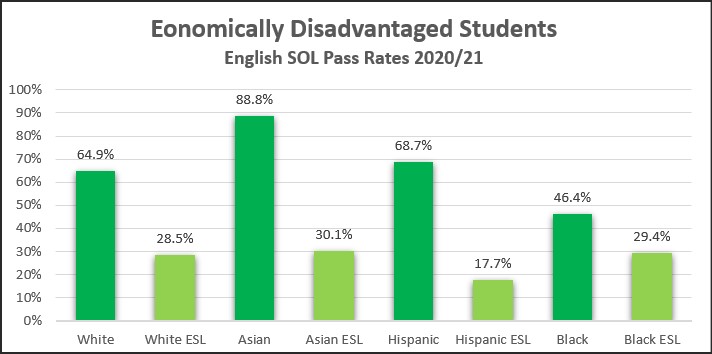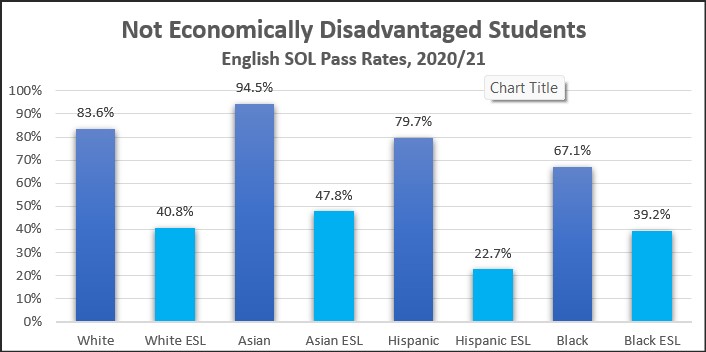It is dogma among practitioners of Critical Race Theory (or whatever other label you wish to apply to the doctrines of the Woke) that Hispanics are akin to Blacks in being “under-represented minorities,” or URMs for short. As URMs, Hispanics are said to be victimized by systemic racism, White privilege, and Whiteness, as evidenced by the disparities in educational achievement between black and brown people on the one hand and Whites and Asians (who are deemed “White-adjacent” even when their skin color is dark) on the other.
Leftist ideology holds that Hispanics are victims of discrimination — either from individual bias, structural racism, or both. But are they? Is it not possible that the No. 1 challenge holding back Hispanic academic achievement in Virginia public schools is the language barrier?
A high percentage of Hispanics come to the United States from poor countries with little education and minimal working knowledge of English. They have to learn the language when they get here. That’s not a monumental problem for adults living in self-contained communities where everyone speaks Spanish, but it is an obstacle for school-age kids who have no choice but to learn the language — especially when school districts are hard-pressed to find teachers qualified to teach English as a second language.
Scarcity of teachers capable of teaching in Spanish is a very different problem than endemic bias and racism, and it calls for different solutions.
The Virginia Department of Education maintains a deep database enabling an analysis of the relationship between various demographic factors and Standards of Learning test scores, which are the primary metric used to gauge the extent of disparities in educational outcomes.
I have created two charts — one of economically disadvantaged students (those qualifying for free lunch programs), seen at the top of this post, and one of NOT economically disadvantaged students (everyone else), seen below. Within each of those groups, I broke down the four main racial/ethnic categories — White, Asian, Hispanic and Black — by those who are enrolled in English Learning programs and those who are not.
Take a look at the graph above. Among economically disadvantaged students, Hispanic students who are fluent in English pass SOL English tests at slightly higher rates than Whites and significantly higher rates than Blacks. The White-Hispanic disparity disappears. Whatever accounts for overall disparities between Whites and Hispanics in SOL reading pass rates, it is not systemic racism.
It’s a different story when comparing Hispanics with Whites who are still learning English. Hispanics pass at half the rate of Whites. The disparity is enormous. Why would there be a White/Hispanic disparity for English Learners but not for students who are fluent in English? My working hypothesis is this: Hispanic students come disproportionately from low-income Central American countries with poor educational systems, where most students learned little or no English. By contrast, Whites come from European countries with better education systems that gave them earlier and more intensive exposure to English. They have less ground to make up. Racism has nothing to do with it.
Along these lines, it is instructive to compare the experience of economically disadvantaged Black English Learners. They pass their English reading SOLs at a higher rate than White and Hispanic English Learners, and trail Asians by only a small percentage. Here also the disparity disappears. If racism is so ubiquitous, why would that be? My working hypothesis is that Black English Learners are from the Caribbean or Africa and they bring with them none of the cultural baggage of native-born, English-speaking Blacks, who, because of a variety of historical and contemporary ideological reasons unique to the United States, are more likely to reject academic excellence as a sign of “Whiteness.” African and Caribbean Blacks don’t have that hang-up.
We see the same patterns among students who are NOT economically disadvantaged, as seen in this chart.
English-speaking Hispanics pass English SOL reading exams at nearly the same rate as Whites. But there is a small disparity — four percentage points — that is worth exploring. My working hypothesis is that the difference can be accounted for by the fact that Hispanics are more likely than Whites to attend low-performing schools. In other words, the quality of the schools accounts for the difference. When Hispanic students move into better school systems, the disparity likely disappears. But follow-up analysis is needed.
Another familiar pattern is that among NOT economically disadvantaged students, Black English Learners pass their English reading SOLs at almost the same rate as Whites — a gap of only 1.6 percentage points. What happened to all the White bias and structural racism?
(Asians, whether economically disadvantaged or not, pass at higher rates than their peers across the board.)
The biggest disparity among the NOT economically disadvantaged is found between Hispanic-speaking English Learners and everyone else. This comes as a surprise to me. After all, White English Learners encompass a wide range of languages from Russian to Romanian, Asian English Learners from Urdu to Korean, and African/Caribbean English Learners from Haitian French to any number of Bantu dialects. Good luck finding teachers conversant in all those tongues! Why the problem with Hispanic English Learners, who all speak Spanish? Perhaps the explanation is the same as for economically disadvantaged Hispanics — poor schooling in their native countries. I don’t know.
I would suggest that, if our goal is to actually improve educational outcomes as opposed to imposing leftist ideology, answering that particular question would be a good place to start. Marinating students, parents, teachers, and administrators in the ideology of grievance, viewing all problems through the prism of White supremacy, sheds zero light on the problems confronting Hispanic English Leaners. Virginia needs solutions grounded in practical reality, not ideology.



Leave a Reply
You must be logged in to post a comment.